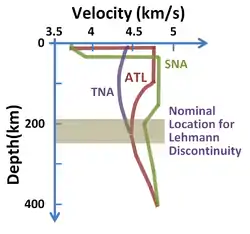
Velocity of seismic S-waves in the Earth near the surface in three tectonic provinces: TNA = Tectonic North America, SNA = Shield North America and ATL = North Atlantic.[1]
The Lehmann discontinuity is an abrupt increase of P-wave and S-wave velocities at the depth of 220 km (140 mi), discovered by seismologist Inge Lehmann.[2][3][4] The thickness is 220 km . It appears beneath continents, but not usually beneath oceans,[5] and does not readily appear in globally averaged studies. Several explanations have been proposed: a lower limit to the pliable asthenosphere, a phase transition,[6] and most plausibly, depth variation in the shear wave anisotropy.[7] Further discussion of the Lehmann discontinuity can be found in the book Deformation of Earth Materials by Shun-ichirō Karato.[8]
Notes
- ↑ Figure patterned after Don L Anderson (2007). New Theory of the Earth (2nd ed.). Cambridge University Press. p. 102, Figure 8.6. ISBN 978-0-521-84959-3.; Original figure attributed to Grand and Helmberger (1984)
- ↑ William Lowrie (1997). Fundamentals of geophysics. Cambridge University Press. p. 158. ISBN 0-521-46728-4.
- ↑ Lehmann, I. (1936): P', Publications du Bureau Central Seismologique International, Série A, Travaux Scientifique, 14, 87–115.
- ↑ Martina Kölbl-Ebert (December 2001). "Inge Lehmann's paper: " P' " (1936)" (PDF).
- ↑
Lars Stixrude and Carolina Lithgow-Bertolloni (2005). "Mineralogy and elasticity of the oceanic upper mantle: Origin of the low-velocity zone". J. Geophys. Res. 110 (B3): B03204. Bibcode:2005JGRB..110.3204S. doi:10.1029/2004JB002965. hdl:2027.42/94924.
The first possible explanation is that the Lehmann is not a global feature...the Lehmann is more prevalent under continents and may be absent under all or most of the oceans.
- ↑ Kent C. Condie (1997). Plate tectonics and crustal evolution (4th ed.). Butterworth-Heinemann. p. 123. ISBN 0-7506-3386-7.
- ↑ MK Savage, KM Fischer CE Hall (2004). "Strain modelling, seismic anisotropy and coupling at strike-slip boundaries...". In John Gocott (ed.). Vertical coupling and decoupling in the lithosphere; Volume 227 of special publications. Geological Society. p. 14. ISBN 1-86239-159-9.
- ↑ Shun-ichirō Karato (2008). Deformation of earth materials: an introduction to the rheology of solid earth. Cambridge University Press. p. 318. ISBN 978-0-521-84404-8.
General references
- P. Caloi (1967). "The "20° Discontinuity"". In H. E. Landsberg, J. Van Mieghem (ed.). Advances in geophysics, Volume 12. Academic Press. p. 167 ff. ISBN 0-12-018812-0. – some historic background.
External links
This article is issued from Wikipedia. The text is licensed under Creative Commons - Attribution - Sharealike. Additional terms may apply for the media files.